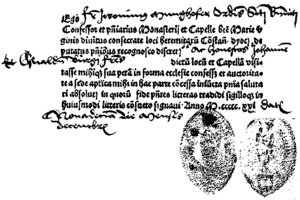Indulgence facts for kids
An indulgence is a special act in the Catholic Church. It means that a person's punishment for sins, which have already been forgiven, is removed. This punishment is usually thought of as something that happens on Earth or after death.
The Church gives an indulgence after a person has confessed their sins and received absolution (forgiveness). Indulgences took the place of very strict punishments used in the early Church.
Contents
What Indulgences Were Based On
The idea behind indulgences was that the Church had a "treasury of merit." This was like a bank of good deeds. These good deeds came from Christians who had done more good than needed to reach salvation (go to heaven).
The Pope, as the leader of the Catholic Church, could use this "bank" of good deeds. He could give or sell these good deeds to others. This was meant to help people whose sins might stop them from being saved.
Indulgences and the Crusades
During the crusades, the Pope made a special promise. He offered a "full indulgence" to those who chose to fight the Muslims. This meant that if these soldiers died in battle, they would go straight to heaven. This was promised even if they had done bad things in their lives.
How Indulgences Changed Over Time
By the year 1500, indulgences had changed a lot. They became printed letters. These letters said that if a person paid money, they would receive full forgiveness for all their sins.
People even believed that if a living person paid for an indulgence, someone who had died and was suffering in purgatory could be freed right away. The money collected from these sales was often used to build churches, like a big church in Rome. Some money also went to local leaders.
The Protest Against Indulgences
The way indulgences were being sold led to many problems. Martin Luther strongly spoke out against them. Luther was a German monk and professor. He said it was better to give money to the poor. He also said people should truly regret their sins instead of just paying money to the Church.
Luther's protest was a major starting point for the Protestant Reformation in 1517. Soon after, the Catholic Church held a meeting called the Council of Trent. At this meeting, the Church tried to fix the problems that led to the Reformation. The sale of indulgences was then stopped.
Indulgences Today
In modern times, the Catholic Church still uses the idea of indulgences sometimes. However, they are not sold for money anymore. Today, indulgences are given as a reward for certain religious acts. They are not seen as a full pardon for sins in the same way they once were.
Images for kids
-
Inscription on the Archbasilica of St. John Lateran in Rome: Indulgentia plenaria perpetua quotidiana toties quoties pro vivis et defunctis (English: "Perpetual everyday plenary indulgence on every occasion for the living and the dead")
-
Archbishop Socrates B. Villegas bestows the Easter Mass Plenary Indulgence in 2012 (St. John the Evangelist Metropolitan Cathedral, Dagupan City, Pangasinan).
-
Engraving of the Mass of Saint Gregory by Israhel van Meckenem, 1490s, with an unauthorized indulgence at the bottom
-
Satan distributing indulgences, an illumination from a Czech manuscript, 1490s; Jan Hus had condemned the selling of indulgences in 1412.
See also
 In Spanish: Indulgencia para niños
In Spanish: Indulgencia para niños










